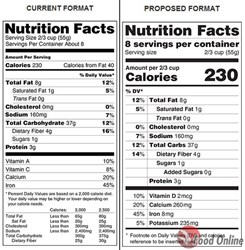FDA Claims Huge Benefits From Label Changes, But Could Cost Manufacturers Billions
By Isaac Fletcher, contributing writer, Food Online

Food manufacturers face new complications, including major financial concerns, as changes to improve nutrition label information go into effect
The more than 500 pages of regulations and legislation for the revised nutrition facts labels include proposed changes regarding the adjustments in daily values — the referenced daily intakes — of nutrients such as sodium and calcium. For example, based on a 2,000 calorie diet, the daily value for calcium would increase to 1,300 milligrams, up from 1,000 milligrams. Another common nutrient, potassium, would have its daily values increased from 3,500 milligrams to 4,700 milligrams, and fiber would increase from 25 grams to 28 grams.
While the goal of the labeling changes is to expand consumer knowledge and provide more accurate information, they may complicate matters for food manufacturers. The FDA estimates the food industry will spend about $2 billion to accommodate the label changes, but the actual costs may be much higher and extend beyond the label changes themselves.
Jillian Wein Riley, an associate with consulting firm Reed Smith and former FDA attorney, explains, “There’s going to be a huge investment in companies changing whole marketing strategies. One cup of milk would have 23 percent of the daily value [for calcium], whereas it’s 30 percent now. From a marketing perspective, one-fifth doesn’t sound nearly as good as one-third.” Regardless of the associated costs, whatever the price may end up being, the FDA argues that the benefits are worth it, claiming the new information could reduce obesity-related health care costs by $30 billion over the next 20 years.
However, some critics question the accuracy of those numbers. Bruce Silverglade, an attorney and food regulation specialist argues, “We know that the changes are going to cost the food industry billions of dollars, that’s for sure.” But, noting the complications in predicting the long-term benefits from the changes, Silverglade goes on to say, “The estimated benefits are more elusive and depend on a myriad of factors.” While the question of whether or not the benefits will outweigh the costs is not fully answered, one thing is certain: labeling changes will force food manufactures to adapt.
